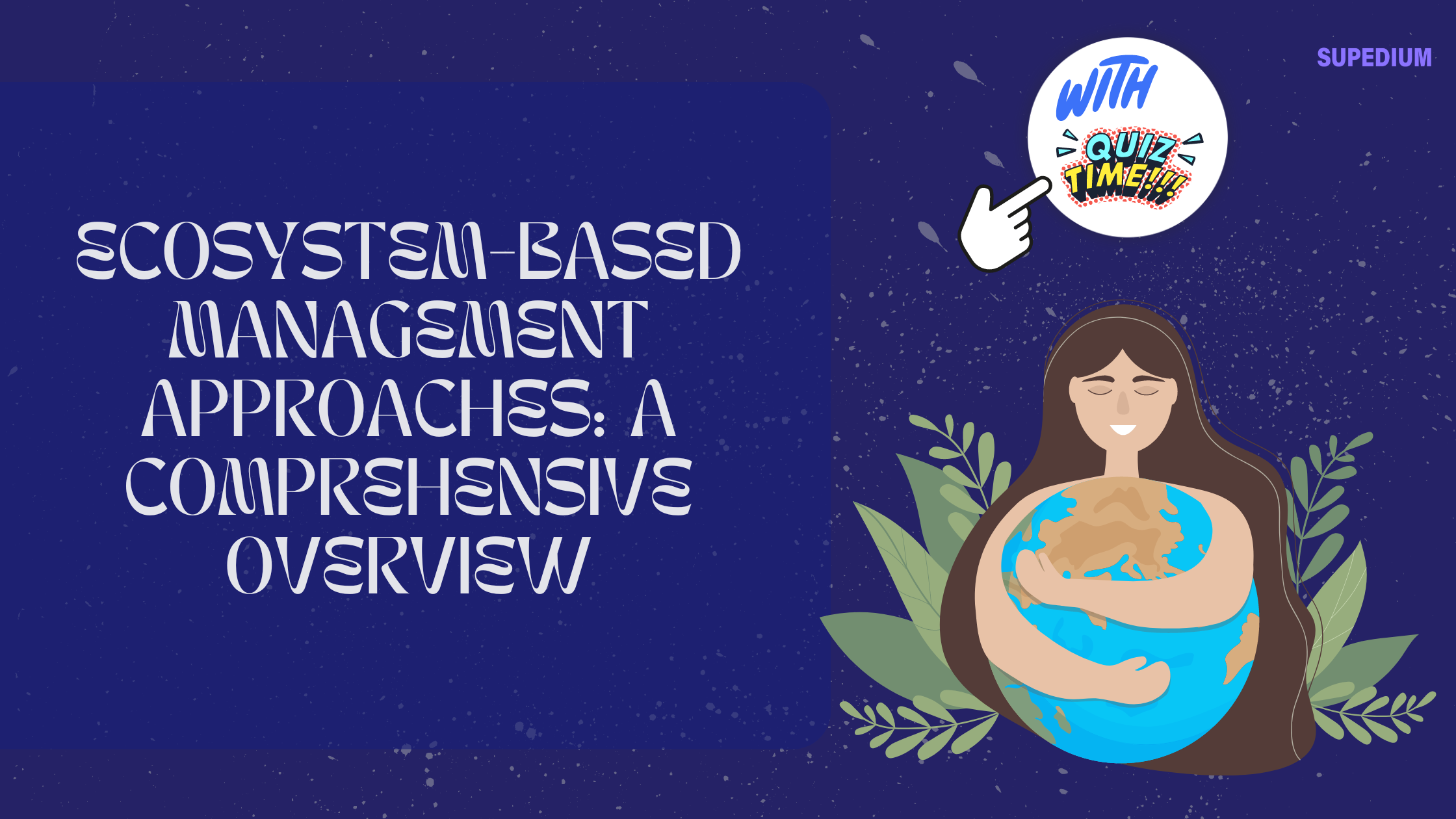Table of Contents
- 1 Introduction to Ecosystem-Based Management
- 2 Principles of Ecosystem-Based Management
- 3 Components of Ecosystem-Based Management
- 4 Tools and Techniques in Ecosystem-Based Management
- 5 Case Studies of Ecosystem-Based Management
- 6 Challenges and Limitations
- 7 Future Directions in Ecosystem-Based Management
- 8 Conclusion
- 9 Quiz Time
![]()
Introduction to Ecosystem-Based Management
Ecosystem-Based Management (EBM) is an integrated approach to managing natural resources that emphasizes the importance of considering entire ecosystems rather than focusing on individual species or resources in isolation. This management strategy recognizes the complex interdependencies between ecological, social, and economic systems, aiming to sustain ecosystem health while meeting human needs.
The need for EBM has grown as traditional resource management approaches often fail to account for the intricate relationships within ecosystems. EBM offers a more holistic perspective, focusing on maintaining ecosystem integrity and resilience to ensure long-term sustainability. Historically, the shift towards EBM represents a move from conventional, single-species management practices to a broader, systems-based approach, evolving through key milestones such as the development of ecosystem services concepts and adaptive management frameworks.
Principles of Ecosystem-Based Management
EBM is underpinned by several core principles:
- Holistic Perspective: EBM integrates ecological, social, and economic dimensions, recognizing that human activities and natural systems are interconnected. This approach seeks to manage the interactions between these dimensions to achieve balanced outcomes.
- Ecosystem Health and Function: Maintaining or improving ecosystem processes and structures is central to EBM. This involves ensuring that ecosystems can continue to perform their essential functions, such as nutrient cycling and habitat provision, which are critical for sustaining biodiversity and human well-being.
- Adaptive Management: EBM embraces an adaptive management approach, which involves learning from management outcomes and adjusting strategies based on new information. This principle allows for flexibility in addressing uncertainties and changing conditions.
- Sustainability: EBM aims to achieve long-term sustainability by considering the future impacts of current actions on ecosystems and human communities. This includes ensuring that ecosystem services remain available for future generations.
- Stakeholder Involvement: Effective EBM requires the engagement of various stakeholders, including local communities, governments, and organizations. Collaborative decision-making helps to incorporate diverse perspectives and address conflicting interests.
- Ecosystem Services: EBM recognizes the value of ecosystem services, which are the benefits that ecosystems provide to humans, such as clean water, air, and food. By maintaining ecosystem health, EBM supports the continued provision of these essential services.
Components of Ecosystem-Based Management
Implementing EBM involves several key components:
- Ecosystem Assessment: The first step in EBM is to assess the current state of ecosystems and their services. This includes evaluating ecological conditions, identifying key components and processes, and understanding how these interact with human activities.
- Management Goals and Objectives: Setting clear, measurable, and achievable goals is crucial for guiding EBM efforts. These goals should reflect desired outcomes for ecosystem health and human well-being, providing a basis for developing and implementing management strategies.
- Implementation Strategies: Effective EBM involves selecting and applying strategies to achieve management goals. These may include establishing protected areas, implementing sustainable land-use practices, or undertaking habitat restoration projects.
- Monitoring and Evaluation: Regular monitoring and evaluation are essential for assessing the effectiveness of management strategies and ensuring that goals are being met. This involves collecting and analyzing data on ecosystem conditions and adjusting management practices as needed.
- Adaptive Management: Based on monitoring results and new information, adaptive management involves modifying strategies to address emerging issues and improve outcomes. This iterative process helps to manage uncertainties and enhance the resilience of ecosystems.
Tools and Techniques in Ecosystem-Based Management
Several tools and techniques support the implementation of EBM:
- Modeling and Simulation: Models and simulations are used to predict ecological outcomes and assess the potential impacts of different management scenarios. These tools help to inform decision-making by providing insights into how ecosystems may respond to various interventions.
- Geographic Information Systems (GIS): GIS technology enables the mapping and spatial analysis of ecosystems, facilitating planning and decision-making. GIS helps to visualize ecosystem conditions, identify areas of concern, and evaluate the effects of management actions.
- Remote Sensing: Remote sensing involves collecting data on ecosystem conditions from satellite imagery and aerial surveys. This technique provides valuable information on land cover changes, vegetation health, and other environmental variables.
- Participatory Approaches: Engaging communities and stakeholders in the management process is essential for EBM. Participatory approaches ensure that local knowledge and perspectives are incorporated into decision-making, fostering greater support and collaboration.
- Decision Support Systems: These systems integrate data and provide tools for analyzing and making informed management decisions. They help to evaluate trade-offs, assess risks, and identify optimal strategies for achieving management goals.
Case Studies of Ecosystem-Based Management
Examining real-world examples of EBM provides insights into its application and effectiveness:
- Marine Ecosystems: The Great Barrier Reef Marine Park Authority employs EBM strategies to manage one of the world’s most complex marine ecosystems. This approach includes zoning, monitoring, and stakeholder engagement to protect coral reefs and associated marine life.
- Forestry and Land Use: In the Pacific Northwest, USA, collaborative forest management practices illustrate EBM in action. By involving various stakeholders in forest planning and management, these practices aim to balance ecological health with economic and social objectives.
- Wetland Restoration: The Florida Everglades Restoration Project is a prominent example of EBM applied to wetland ecosystems. The project seeks to restore natural water flow patterns and improve habitat conditions to support diverse species and ecosystem functions.
- Urban Ecosystems: Green infrastructure initiatives in cities like New York and Copenhagen demonstrate how EBM principles can be applied in urban settings. These projects focus on integrating natural systems into urban planning to enhance environmental quality and resilience.
Challenges and Limitations
While EBM offers many benefits, it also faces several challenges:
- Complexity of Ecosystems: Understanding and managing the complexities of ecosystems can be difficult due to the numerous interactions and feedback mechanisms involved. This complexity makes it challenging to predict outcomes and design effective management strategies.
- Data Gaps and Uncertainties: Limited data and scientific knowledge can hinder the ability to accurately assess ecosystem conditions and predict the impacts of management actions. Addressing these gaps requires ongoing research and data collection.
- Conflicting Interests: Balancing the needs and interests of diverse stakeholders can be challenging. Conflicts may arise between conservation goals and economic or social objectives, requiring careful negotiation and compromise.
- Financial and Resource Constraints: Implementing EBM strategies often requires significant financial and resource investments. Limited budgets and resources can restrict the scope and effectiveness of management efforts.
- Policy and Governance Issues: Effective EBM relies on coherent policies and strong governance structures. Inconsistent or fragmented policies can undermine management efforts and hinder the achievement of desired outcomes.
Future Directions in Ecosystem-Based Management
Looking ahead, several trends and advancements are shaping the future of EBM:
- Integration with Climate Change Adaptation: EBM is increasingly being integrated with climate change adaptation strategies. This involves addressing the impacts of climate change on ecosystems and incorporating resilience-building measures into management plans.
- Advancements in Technology: Emerging technologies, such as advanced remote sensing and data analytics tools, are enhancing the ability to monitor and manage ecosystems. These advancements provide new opportunities for improving management practices and decision-making.
- Strengthening Collaboration: Future EBM efforts are likely to place greater emphasis on strengthening collaboration among stakeholders, sectors, and countries. Enhanced cooperation can help to address complex challenges and achieve more effective outcomes.
- Education and Awareness: Promoting education and awareness about EBM principles is crucial for building support and fostering informed decision-making. Engaging the public and decision-makers in understanding and applying EBM can drive positive change and support sustainable practices.
Conclusion
Ecosystem-Based Management represents a comprehensive and integrated approach to managing natural resources and environmental systems. By considering the interconnectedness of ecological, social, and economic factors, EBM aims to achieve long-term sustainability and resilience. Despite its challenges, EBM offers valuable tools and principles for addressing complex environmental issues and ensuring the health of ecosystems for future generations. As we continue to face global environmental challenges, embracing EBM and advancing its practices will be essential for achieving a sustainable and balanced relationship between humans and the natural world.






Be the first to comment